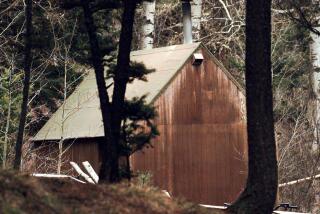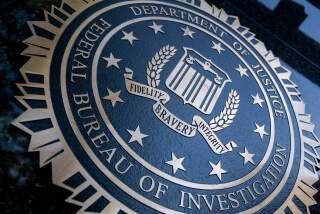Suspect’s Cabin Yields Trove of Items, FBI Says
- Share via
HELENA, Mont. — The tiny mountain cabin of Unabomber suspect Theodore J. Kaczynski has yielded a treasure trove of evidence, including hand-marked containers of chemicals, wooden casings for homemade bombs, a prescription drug used for treating serious cases of depression and an intriguing hint at a possible autobiography, FBI officials revealed in documents released Monday.
Among more than 850 items removed by the FBI from Kaczynski’s secluded shack were five guns, makeup, tools that could be used in fashioning bombs, “bomb components” and a plastic jar of triggering devices, according to a detailed report on the 10-day search of the cabin filed with the federal district court here.
Federal agents also recovered documents that may help track Kaczynski’s movements over the last two decades, including checkbooks issued on a Montana bank account and a “brown clasped envelope marked ‘autobiography,’ ” according to the report on the search.
The 34-page list of items, which was ordered unsealed by U.S. District Judge Charles C. Lovell, indicates the FBI has amassed a substantial pile of evidence linking the former UC Berkeley math professor to the elusive serial bomber who killed three and injured 23 others over 18 years.
“It’s all going to show a very neat package here of this guy’s behavior,” said one source familiar with the investigation.
Included on the list are items that have already become public: a completed package bomb; a partially constructed pipe bomb; a typewriter that appears to match the writing on documents sent by the Unabomber, and glasses and a hooded garment similar to those worn by the bomber in the only known sighting and widely publicized in a police artist’s sketch.
The original copy of the Unabomber’s 35,000-word manifesto also was found in the cabin, sources said, but the FBI list identifies only several packets of documents and does not specify their contents. The Unabomber typed the manuscript using carbon paper to make four copies that he mailed to newspapers, magazines and a Berkeley psychology professor; carbon paper also was found in the cabin, kept in a K mart shopping bag, according to the FBI list.
Long before the FBI ever heard of Kaczynski, investigators theorized that the Unabomber was a pack rat who stored materials for years--even using the same roll of wire in most of his bombs.
And, if Kaczynski is indeed the Unabomber, he apparently was not concerned about the amount of evidence he might provide agents if they were to find him.
*
On the evidence list are dozens and dozens of containers of chemicals that could be used in bomb-making, including smokeless powder, aluminum powder, ammonium nitrate and manganese dioxide.
Kaczynski also kept dozens of pieces of pipe, copper tubing, metal fragments and other potential bomb parts in his 10-by-12-foot cabin, according to the FBI list.
Much of his collection was stored in everyday household containers: Quaker Oats canisters, Calumet baking powder cans, bread bags, soapboxes, coffee jars and pill bottles.
For example, one such container was an old Bayer aspirin bottle with the handwritten label: “LEAD CHLORIDE--CONTAMINATED WITH SOME HYDROXIDE, OXIDE OR CARBONATE OF LEAD.” A Del Monte whole-leaf spinach can was used to store melted metal fragments.
The evidence list also hinted at the psychological makeup of Kaczynski, who abruptly left his tenure-track position at UC Berkeley in 1969 to survive in meager solitude on a series of menial jobs. FBI agents searching the cabin found the prescription drug trazodone, a powerful antidepressant.
According to the manufacturer’s label, trazodone is generally prescribed for people who suffer from major depressive episodes that last for a week or more. There is no indication from the evidence list how long or how often Kaczynski might have been taking the medication. Federal agents are investigating his medical history to learn more about his behavior.
The evidence list also indicates that Kaczynski, who graduated from Harvard when he was barely 20, read widely. Among about 200 books in the dim, cramped cabin were such titles as: “Eastern Mysticism,” the “Holy Bible Dictionary Concordance,” Vols. I and II of “Les Miserables” and “Growing Up Absurd.”
While investigators strongly believe that Kaczynski acted alone, the documents also made clear they have not closed their minds to the possibility that he conspired with others. The agents and technicians, the warrant noted, were looking for “any and all literature, documents, materials, books, correspondence, membership lists, written materials, or computer-generated and stored lists which relate to the identity of any co-conspirators who may be involved in any of the aforementioned bombing incidents.”
In addition, the files note that agents were looking for any information related to names previously associated with the Unabomber’s work, including “Wu” and the Sloan Wilson book, “The Ice Brothers,” which was used in one of the bombings.
In 1982, when the Unabomber struck a computer science and engineering building at UC Berkeley, he left a note stating: “Wu--It works! I told you it would. RV.”
In the late 1960s, when Kaczynski taught at Berkeley, Hung-Hsi Wu was a fellow math professor. Wu reportedly told the FBI he does not remember anything about Kaczynski, but must have known him casually because they were in the same department.
RV is another set of initials that agents were on the lookout for.
*
In 1980, when the Unabomber mailed a bomb to Percy Wood, then president of United Airlines, he enclosed the explosive in the book “The Ice Brothers.” The search warrant listed the book “or portions thereof” among the bomb containers that agents were hoping to find.
The judge declined, however, to release some of the case’s most intriguing details--keeping some documents under seal.
One former FBI official, emphasizing he had no information on which to base his “speculation,” said he assumed agents had managed to plant a spike microphone or other surreptitious listening device in Kaczynski’s cabin during the weeks they were conducting surveillance at the site. If so, that information would be included in the documents that remain sealed.
Such surveillance might also be continuing.
Paddock reported from Helena and Ostrow from Washington. Times staff writer John Balzar in Helena and researcher D. J. Salem in Washington contributed to this story.
(BEGIN TEXT OF INFOBOX / INFOGRAPHIC)
Items Found in Cabin
An FBI list of evidence seized from Unabomber suspect Theodore Kaczynski’s cabin in Montana contained 585 entries. Some entries contained several items. Items seized included:
* Bomb components
* Improvised explosive device
* Pipe bomb
* Improvised detonator
* Plastic jar containing triggering devices
* Box containing “miscellaneous papers, newspaper clippings, bus schedule, addresses of corporate officials and maps of San Francisco”
* .25-caliber gun (Raven Arms), magazines containing bullets
* Bolt-action .22-caliber rifle
* Hand-made gun with spent cartridge
* Gun cleaning kit
* Hand tools, including file, drill bits, saws, tweezers and hacksaw
* 232 books
* 16 notebooks or binders
* Three typewriters
* Seven rolled-up maps
* White piece of paper that appears to be some kind of mathematics equations
* Plastic shopping bag containing Montana driver’s license and $32 cash
* One bottle of Trazadone, antidepressant
Source: Associated Press
More to Read
Sign up for Essential California
The most important California stories and recommendations in your inbox every morning.
You may occasionally receive promotional content from the Los Angeles Times.










